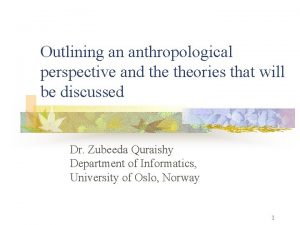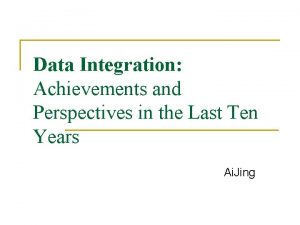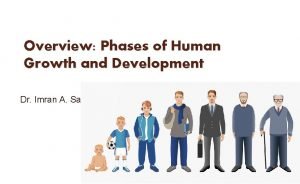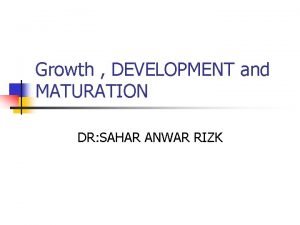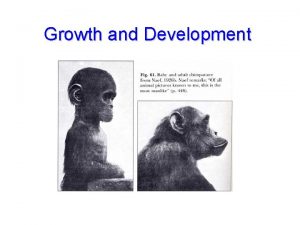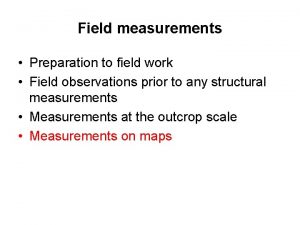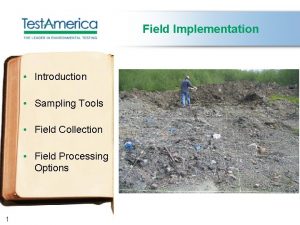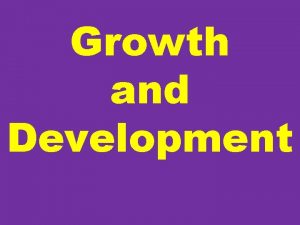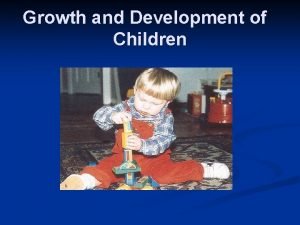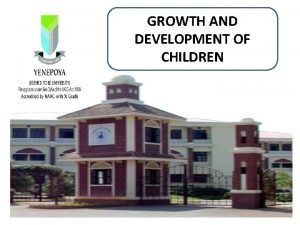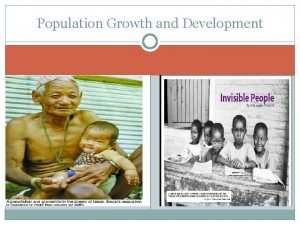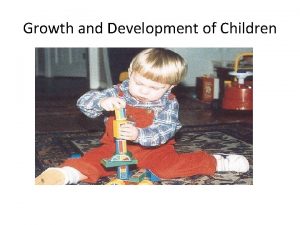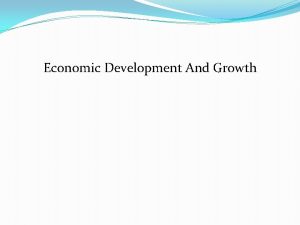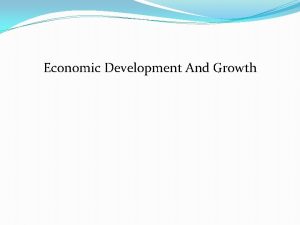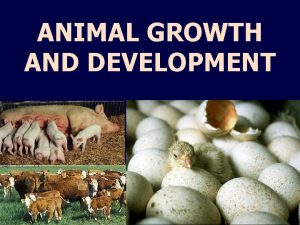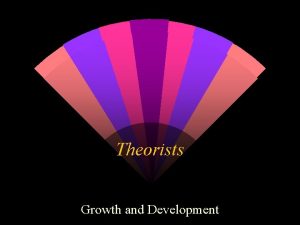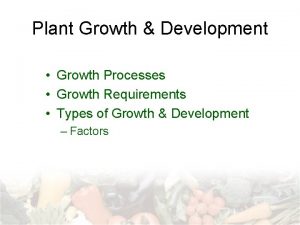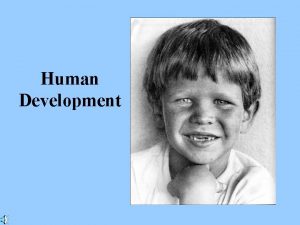Perspectives on Growth and Development Field of growth





































- Slides: 37

Perspectives on Growth and Development • Field of growth and development takes on fundamental questions: Why are some countries rich and some poor? What impediments prevent, and what policies enable, a country to go from poor to rich – to grow and reduce poverty? These are big questions, but not easy ones Prepared for Seminar at Higher School of Economics, Nizhny Novgorod

Perspectives on Growth and Development • Field of growth and development takes on fundamental questions: Why are some countries rich and some poor? What impediments prevent, and what policies enable, a country to go from poor to rich – to grow and reduce poverty? These are big questions, but not easy ones Prepared for Seminar at Higher School of Economics, Nizhny Novgorod

Perspectives on Growth and Development • Recent heavy focus on Sub-Saharan Africa, and second on South Asia (India, Pakistan, Bangladesh) – by international development institutions, private donor agencies, etc. Less on East Asia, Latin America, East Europe and Central Asia Why? Africa, South Asia are currently where most severe poverty is located – less than $1 or $2 per day Strong focus on severe poverty, for obvious reasons and related to UN “Millenium Development Goals” – goals focused on reduction of extreme poverty and improvement of indicators from low levels Prepared for Seminar at Higher School of Economics, Nizhny Novgorod

Perspectives on Growth and Development Eminent Perspectives on Economic Development • Lucas, UChicago (Nobel laureate): Possibilities for staggering impact on human well-being “Rates of growth of real per-capita income are. . . diverse, even over sustained periods. . Indian incomes will double every 50 years; Korean every 10. An Indian will, on average, be twice as well off as his grandfather; a Korean 32 times. . I do not see how one can look at figures like these without seeing them as representing possibilities. Is there some action a government of India could take that would lead the Indian economy to grow like Indonesia’s or Egypt’s? If so, what, exactly? If not, what is it about the ‘nature of India’ that makes it so? The consequences for human welfare involved in questions like these are simply staggering: Once one starts to think about them, it is hard to think about anything else. ” Lucas, 1988 Prepared for Seminar at Higher School of Economics, Nizhny Novgorod

Perspectives on Growth and Development Eminent Perspectives on Economic Development • Lucas, UChicago (Nobel laureate): Possibilities for staggering impact on human well-being • Sachs, Columbia: The End of Poverty in our reach … concerted, large, intelligent, temporary foreign aid can do it Prepared for Seminar at Higher School of Economics, Nizhny Novgorod

Perspectives on Growth and Development Eminent Perspectives on Economic Development • Lucas, UChicago (Nobel laureate): Possibilities for staggering impact on human well-being • Sachs, Columbia: The End of Poverty in our reach • Easterly, NYU: No Secret to Development, no top-down and planned solutions, instead need freedom for bottom-up, homegrown solutions & institutions to be developed Prepared for Seminar at Higher School of Economics, Nizhny Novgorod

Perspectives on Growth and Development Eminent Perspectives on Economic Development • Lucas, UChicago (Nobel laureate): Possibilities for staggering impact on human well-being • Sachs, Columbia: The End of Poverty in our reach • Easterly, NYU: No Secret to Development, but freedom • Banerjee and Duflo, MIT: Answers to “Big Questions” not possible, but progress in understanding little pieces of development is possible; eventually, with luck, the little things will add up to development Prepared for Seminar at Higher School of Economics, Nizhny Novgorod

Perspectives on Growth and Development Eminent Perspectives on Economic Development • Lucas, UChicago (Nobel laureate): Possibilities for staggering impact on human well-being • Sachs, Columbia: The End of Poverty in our reach • Easterly, NYU: No Secret to Development, but freedom • Banerjee and Duflo, MIT: Answers to “Big Questions” not possible, focus on answering little questions well • Jesus: Material advance not the only thing that matters “What good is it for a man to gain the whole world, yet forfeit his soul? ” Jesus, ca. 30 A. D. (Mark 8: 36) Prepared for Seminar at Higher School of Economics, Nizhny Novgorod

Perspectives on Growth and Development • Recent trends in the field: Toward micro, away from macro Toward empirical research, away from theoretical Researchers like Banerjee and Duflo (MIT) seem to currently be winning the day: putting the focus on answering small questions well, rather than tackling big questions less convincingly Prepared for Seminar at Higher School of Economics, Nizhny Novgorod

Perspectives on Growth and Development • Recent trends in the field: Toward micro, away from macro Toward empirical research, away from theoretical Trend in economics generally has been toward empirics Why? Probably: 1) Technological change (supply) – data analysis much easier, data availability greater now than several decades ago 2) Driven by theory (demand) – All rational neo-classical models “похожи друг на друга”; every market model with frictions (asymmetric information, behavioral assumptions, etc. ) makes predictions “по-своему” Theory can say anything, need to test empirically Prepared for Seminar at Higher School of Economics, Nizhny Novgorod

Perspectives on Growth and Development • Recent trends in the field: Toward micro, away from macro Toward empirical research, away from theoretical – Why? Macro questions often bigger, but harder to answer Cross-country OLS regression has problems due to omitted variables and/or reverse causality Ex. Does high human capital cause high income, or the reverse? One way to deal with this has been regressions in differences rather than levels: growth of income, rather than level of income (or fixed effect panel regressions) But similar problems: do high rates of investment cause high growth, or does high growth induce high rates of investment? Prepared for Seminar at Higher School of Economics, Nizhny Novgorod

Perspectives on Growth and Development • Recent trends in the field: Toward micro, away from macro Toward empirical research, away from theoretical – Why? Macro questions often bigger, but harder to answer IV also has problems: “Exclusion restriction” likely violated Very hard at the country level to say instrument Z affects Y only through X – countries are complex, and rarely do we know there is only one kind of effect from a given variable Ex. One of the most cited papers on corruption: Mauro (1995) shows that higher corruption associated with slower growth, using IV = ethnic diversity (probability two randomly chosen citizens belong to different ethnolinguistic groups) But couldn’t diversity affect growth apart from affecting corruption? Prepared for Seminar at Higher School of Economics, Nizhny Novgorod

Perspectives on Growth and Development • Recent trends in the field: Toward micro, away from macro Toward empirical research, away from theoretical Why? In short, easier to identify causal impacts, rather than simply correlations, at the micro level So, development economics now often asks smaller, more localized questions rather than big questions Ex. Rather than how does corruption affect growth across countries (Mauro, QJE 1995), now how does corruption affect drivers license process in Delhi, India (Bertrand et al. , QJE 2007)? Prepared for Seminar at Higher School of Economics, Nizhny Novgorod

Perspectives on Growth and Development • Development as micro-empirical. What methods? In general, strong emphasis placed on “identification”, i. e. identifying causal impacts, rather than simple correlations Secondarily, emphasis on supporting or falsifying theory, or testing between theories One methodology that has taken the field by storm in the past 10 years, and raised the standard for causal identification in development economics, and economics more broadly: “Field experiments” – experiments run not in the laboratory, but in real-world environments Prepared for Seminar at Higher School of Economics, Nizhny Novgorod

Perspectives on Growth and Development • Development as micro-empirical. What methods? Field Experiment examples 1) Progresa – a “Conditional Cash Transfer” (CCT) Program in Mexico, a pioneer in experimental evaluation CCT programs transfer money to low-income households, conditional on the households making certain investments: child’s school attendance, child immunizations, mother and child doctor visits, etc. Progresa was rolled out in a random way – target population identified, then a random subset served for the first two years clean “treatment” and “control” groups, can test for program effects on health, schooling, consumption, etc. Prepared for Seminar at Higher School of Economics, Nizhny Novgorod

Perspectives on Growth and Development • Development as micro-empirical. What methods? Field Experiment examples 2) Education Policy – Duflo, Dupas, Kremer What are most cost-effective educational investments? Free textbooks? More teachers/lower class size? Computers? Can use regressions with existing data, but one is typically only finding correlations They run experiments in Kenya schools, randomly funding textbooks, or more teachers; also randomizing student assignment by ability, vs. random clean, “scientific” evidence on policies’ cost-effectiveness Prepared for Seminar at Higher School of Economics, Nizhny Novgorod

Perspectives on Growth and Development • Development as micro-empirical. What methods? Field Experiment examples 3) Microcredit – extension of small loans to relatively poor households to fund business investments By now, 1000 s of microfinance institutions (“MFIs”) have extended loans to several hundred million households worldwide But does it work? Does it help households out of poverty? Difficulty with observational studies: Can compare borrowers with non-borrowers, but might there be unobserved differences causing both borrowing and success? Can compare areas with microcredit access with those without access, but might MFIs entry be correlated with success? Prepared for Seminar at Higher School of Economics, Nizhny Novgorod

Perspectives on Growth and Development • Development as micro-empirical. What methods? Field Experiment examples 3) Microcredit Banerjee, Duflo et al. partner with an MFI in India The MFI lists 100 neighborhoods where it would like to enter, then enters in a randomly selected half of them “clean” test for effect of access to microcredit on households (They find significant increase in business startups, but no effect on consumption, at least in short run) Prepared for Seminar at Higher School of Economics, Nizhny Novgorod

Perspectives on Growth and Development • Development as micro-empirical. What methods? Field Experiment examples 4) MPK in developing countries What is the return to capital in developing countries? Can compare revenues or profits across businesses with different levels of capital and estimate an elasticity – but other things could be varying across businesses that affect both capital levels and returns, e. g. ability or efficiency de Mel, Mac. Kenzie, Woodruff (2008, QJE) give random amounts of capital (money) to microentrepreneurs in Sri Lanka, estimate rates of return to the capital (60% or higher) Prepared for Seminar at Higher School of Economics, Nizhny Novgorod

Perspectives on Growth and Development • Development as micro-empirical. What methods? Field Experiments -- What is the impact of this methodology? 1) Standards for identification have increased – no longer sufficient, often, are simple correlations or instrumental variables that are not well argued for 2) Funding and aid (World Bank, Gates Foundation, etc. ) now often go preferentially to experimentally tested programs 3) Other fields are now increasingly using field experiments also – for educational policy (Fryer, Hoxby), workplace incentives (Barankay), behavioral decision-making and savings (Duflo, Saez), etc. Prepared for Seminar at Higher School of Economics, Nizhny Novgorod

Perspectives on Growth and Development • Development as micro-empirical. What methods? Field Experiments -- Critiques Some prominent critics of the methodology: Deaton, Ravallion, … 1) Ethics – is it ethical to experiment in real-world situations? But: What if we don’t know effects? What if we have willing participants? What if budget constraints necessitate rationing anyway? 2) External validity – we may know how drivers licenses work in Delhi, or MPK in Sri Lanka; what have we learned in general? More subtle critique – in many cases, the experimenter finds a willing participant (e. g. NGO) to try the new policy. But is the “willing participant” representative of the population? Prepared for Seminar at Higher School of Economics, Nizhny Novgorod

Perspectives on Growth and Development • Development as micro-empirical. What methods? Field Experiments -- Critiques 3) Is this really economics? Simply randomly assign several policies, check for mean differences in outcomes… where is the economics? Recent trend toward using experiments to test economic theory, not just to measure policy impacts Ex. Karlan, Zinman (2009, Econometrica) test between different theories of asymmetric information in credit markets: -- adverse selection should respond only to offer rate -- moral hazard should respond only to contract rate they independently vary both offer and contract rate in experimental collaboration with lender, “able” to distinguish between adverse selection and moral hazard Prepared for Seminar at Higher School of Economics, Nizhny Novgorod

Perspectives on Growth and Development • Development as micro-empirical. What methods? Natural Experiments: Find a policy change or event that shifted some key variable in a quasi-random way, not based on any economic reasoning This creates a quasi-experiment since the key variable shifts in a way exogenous to the key outcome Ex. Kaboski and Townsend (2011) study a massive credit program by the Thai govt. that provide 1 million Thai baht to every village to start a village bank. This provides quasi-random variation in infusion of credit per capita, since villages vary in size Prepared for Seminar at Higher School of Economics, Nizhny Novgorod

Perspectives on Growth and Development • Development as micro-empirical. What methods? Difference in Differences: Find a “control group” unaffected by a policy, use them as control group to identify and remove overall trends in the outcome variable Ex. Bharadwaj, Lakdawala (2013) look at effect of Child Labor Ban in India – before-after comparisons of hours worked, but differenced between same-aged children with and without siblings of an age affected by the Ban This intends to control for time trends in hours worked over the period Prepared for Seminar at Higher School of Economics, Nizhny Novgorod

Perspectives on Growth and Development • Development as micro-empirical. What methods? Regression Discontinuity: Programs that exploit a fixed cutoff for eligibility can be evaluated by comparing households just above the cutoff with those just below. If conditional expectations of observables are continuous in the variable used for eligibility, these two groups are nearly identical except in access to program. Ex. Pop-Eleches, Urquiola (2008) look at consequences of attending a more selective school in Romania by comparing students who barely qualified with those who barely did not qualify, based on a national exam Prepared for Seminar at Higher School of Economics, Nizhny Novgorod

Perspectives on Growth and Development • How does Development Economics differ from Growth Economics? (Based on Banerjee, Duflo “Growth Theory Through the Lens of Development Economics” in Handbook of Economic Growth) Growth theory typically begins with aggregate production function Ex. Y=AKαN 1 -α This presumes that there is a single economy-wide MPK. But, there is strong evidence that MPK is not equalized within countries. Micro-empirical studies uncover rates of return as high as 100% Average rates of return cannot be much higher than 20% Prepared for Seminar at Higher School of Economics, Nizhny Novgorod

Perspectives on Growth and Development • How Development Economics differs from Growth Economics There is evidence that MPK is not equalized within countries. Micro-empirical studies uncover rates of return as high as 100% Average rates of return cannot be much higher than 20% This raises key questions mostly ignored in growth theory: Why doesn’t capital flow to uses with higher returns even within poor countries? Why is capital not allocated efficiently within poor countries? Why are such high-return investments not being undertaken? Prepared for Seminar at Higher School of Economics, Nizhny Novgorod

Perspectives on Growth and Development • How Development Economics differs from Growth Economics Why is capital not allocated efficiently within poor countries? Why are such high-return investments not being undertaken? Approaches taken in Development Economics to these questions: 1) Government Failure Government may distort allocations, making connections more important than talent in allocating positions and resources for investment (Murphy, Shleifer, Vishny 1991) Can be due to excessive intervention in economy (corruption, excessive regulation/taxation) and/or insufficient support for market, e. g. not protecting property rights Prepared for Seminar at Higher School of Economics, Nizhny Novgorod

Perspectives on Growth and Development • How Development Economics differs from Growth Economics Why is capital not allocated efficiently within poor countries? Why are such high-return investments not being undertaken? Approaches taken in Development Economics to these questions: 2) Imperfect Credit Markets Why do credit markets function less well in poor economies? a) Information and enforcement systems less developed, due partly to higher costs (e. g. illiteracy) and fewer resources available b) Low wealth and weaker institutions makes collateral harder to rely on c) Political pressure to protect (poor) borrowers from lenders d) Pressure of poverty may raise borrower willingness to default Prepared for Seminar at Higher School of Economics, Nizhny Novgorod

Perspectives on Growth and Development • How Development Economics differs from Growth Economics Why is capital not allocated efficiently within poor countries? Why are such high-return investments not being undertaken? 2) Imperfect Credit Markets Consequences: asymmetric information and weak enforcement borrower characteristics like wealth and monitorability affect access to credit low-wealth borrower or hard-to-monitor project may not get funded even though returns are quite high Many theoretical studies of economic development under imperfect credit markets, and many empirical studies seeking to understand what frictions cause credit markets to fail Prepared for Seminar at Higher School of Economics, Nizhny Novgorod

Perspectives on Growth and Development • How Development Economics differs from Growth Economics Why is capital not allocated efficiently within poor countries? Why are such high-return investments not being undertaken? 2) Imperfect Credit Markets Also, growing body of research on the “Microcredit Movement”, a surprising development that has seen credit extended in small amounts to several hundred million households worldwide Nobel Peace Prize 2006 for microcredit (Yunus, Grameen Bank) Research questions: What innovations enabled successful lending among very poor borrowers throughout the world? Which credit market imperfections were solved, and how? What impact does microcredit have on business formation, income, poverty, and an economy’s overall development trajectory? Prepared for Seminar at Higher School of Economics, Nizhny Novgorod

Perspectives on Growth and Development • How Development Economics differs from Growth Economics Why is capital not allocated efficiently within poor countries? Why are such high-return investments not being undertaken? 3) Imperfect Insurance Markets Large literature (Townsend, 1994) showing that insurance may be largely missing in village economies – poor households face a lot of uninsured risk This can affect investment: some studies show that poor households choose less productive, safer technologies when they face more risk Research questions: How to deliver insurance products to poor households? Why is demand for insurance seemingly so low? Prepared for Seminar at Higher School of Economics, Nizhny Novgorod

Perspectives on Growth and Development • How Development Economics differs from Growth Economics Why is capital not allocated efficiently within poor countries? Why are such high-return investments not being undertaken? 4) Local (Micro-) Externalities Households may underadopt new technologies or underinvest due to positive externalities, and free-riding Ex. Kremer, Miguel (2003) show that investment in deworming medicine is very low even though returns through human capital are very high – a big part is significant positive externalities Ex. Conley and Udry (2003) and others show adoption of better technology can be low, in part because of positive externalities of experimentation, learning, and communication Prepared for Seminar at Higher School of Economics, Nizhny Novgorod

Perspectives on Growth and Development • How Development Economics differs from Growth Economics Why is capital not allocated efficiently within poor countries? Why are such high-return investments not being undertaken? 4) Local (Micro-) Externalities Research has also gotten very technical here with formal graph-theoretic models of networks to capture structure of spillovers across households Data collection has also pushed boundaries by collecting data on relational links for entire villages can construct the entire relational graph, identify “central” households in the village’s social structure Ex. Research has tested whether targeting central households with new technology or program affects overall adoption Prepared for Seminar at Higher School of Economics, Nizhny Novgorod

Perspectives on Growth and Development • How Development Economics differs from Growth Economics Why is capital not allocated efficiently within poor countries? Why are such high-return investments not being undertaken? 5) Behavioral Issues High-return investments may not be made because agents are not acting rationally (contrary to standard economic assumptions) Ex. They may be hyperbolic discounters – discount the near future more heavily than the far future difficulty in saving/investing, demand for commitment devices Studies have shown that commitment devices do help raise savings (but, both in developed and less-developed countries) Prepared for Seminar at Higher School of Economics, Nizhny Novgorod

Perspectives on Growth and Development • How Development Economics differs from Growth Economics Why is capital not allocated efficiently within poor countries? Why are such high-return investments not being undertaken? 5) Behavioral Issues Some have argued that behavioral issues may be different and/or stronger for poorer households (Banerjee, Mullainathan, Ray, Bernheim, Yeltekin) maybe there is a cognitive poverty trap (Interesting pendulum – 50 years ago, households in 3 rd World countries were self-evidently irrational in their choices 20 -30 years ago, economists instead tried to show rationality plus 3 rd World constraints explained household behavior Now, back to irrationality? ) Prepared for Seminar at Higher School of Economics, Nizhny Novgorod

Perspectives on Growth and Development • Field of growth and development takes on fundamental questions: Why are some countries rich and some poor? What impediments prevent, and what policies enable, a country to go from poor to rich – to grow and reduce poverty? These are big questions, but not easy ones In short, much work left to do! Prepared for Seminar at Higher School of Economics, Nizhny Novgorod
 What are the 4 principles of child development
What are the 4 principles of child development Gauss law in magnetism
Gauss law in magnetism Q factor of capacitor
Q factor of capacitor Data types and field properties
Data types and field properties Field dependent definition
Field dependent definition Magnetic field
Magnetic field Individual differences factors
Individual differences factors Field dependent vs field independent
Field dependent vs field independent E field h field
E field h field Growth is defined as an increase in
Growth is defined as an increase in Monocot vs eudicot
Monocot vs eudicot Primary growth and secondary growth in plants
Primary growth and secondary growth in plants Vascular ray
Vascular ray Differences between structural and action perspectives
Differences between structural and action perspectives Health promotion in nursing practice 7th edition
Health promotion in nursing practice 7th edition History of midwifery in india ppt
History of midwifery in india ppt Tok essay 2022
Tok essay 2022 Perspective about anthropology
Perspective about anthropology Unit 10 sociological perspectives health and social care
Unit 10 sociological perspectives health and social care Perspectives and methodology of economics
Perspectives and methodology of economics The social and ethical perspectives of entrepreneurship
The social and ethical perspectives of entrepreneurship Data integration problems approaches and perspectives
Data integration problems approaches and perspectives Personological and life story perspectives
Personological and life story perspectives Gregor andrade
Gregor andrade Define family matters
Define family matters Language paper 2 writers' viewpoints and perspectives
Language paper 2 writers' viewpoints and perspectives Professional nursing practice concepts and perspectives
Professional nursing practice concepts and perspectives Paper 2 writers’ viewpoints and perspectives
Paper 2 writers’ viewpoints and perspectives Social changes in adulthood
Social changes in adulthood Theories on growth and development
Theories on growth and development Stages of human growth and development pictures
Stages of human growth and development pictures Late childhood mental development
Late childhood mental development Pretest: growth, development, and sexuality
Pretest: growth, development, and sexuality Sahar anwar
Sahar anwar Slidetodoc.com
Slidetodoc.com Social development in late childhood
Social development in late childhood Economic development vs economic growth
Economic development vs economic growth Ppst domain 7 reflection
Ppst domain 7 reflection

















